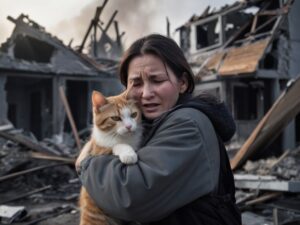As Ukrainians welcomed another year, they faced one of the most intense aerial attacks since the onset of the conflict with Russia.
The capital city Kyiv is bearing the brunt of the recent deadly strikes, with civilians in other metropolises such as Odesa and Kharkiv sharing tales of their somber commencement to 2024.
The year had just begun when the blare of air raid sirens echoed throughout Ukraine. The subsequent four hours ushered in a series of drone and missile onslaughts on Tuesday morning.
 New Year’s Eve offered a scant opportunity for festivities.
New Year’s Eve offered a scant opportunity for festivities.
“Another air raid siren is going off at this moment,” Ukrainian foreign affairs expert Hanna Shelest conveyed via text as she hastened to an underground parking area in Odesa for cover, a champagne flute still in hand.
At 01:00 on New Year’s Day, it marked the second time since the stroke of midnight that the inhabitants of Odesa sought refuge from what Shelest described as “Russian pyrotechnics.”
“The Shahed drones are coming. We first descended here at midnight, and now we must again,” her message continued.
An interactive display depicting air raid alarms illustrated warnings strewn across over half the nation.
That morning, Hanna discovered the drone strikes tragically claimed the life of a 15-year-old boy in Odesa’s south.
Russian-appointed officials contended that Ukrainian forces bombarded the occupied Donetsk region in the east on New Year’s Eve, leading to four fatalities. Without comments from Ukrainian officials, and with foreign journalists restricted from the area, these claims remain unverified.
Russia’s assault aimed at a mourning nation, reeling from over 40 civilian deaths due to attacks on the 29th of December, and another strike in Kharkiv’s center the next day.
In his speech, President Zelensky committed to ramping up domestic arms and ammo production, aiming for a minimum of a million drones.
Russia’s Vladimir Putin omitted any reference to the war in his New Year remarks, though he later pledged to “amplify” campaigns against Ukraine.
For residents in Crimea, the new year posed distinct challenges.
A local under Russian control reported their festivities via a secure messaging platform, showcasing a photo of a Christmas tree ornamented with a bauble featuring the Ukrainian yellow trident emblem.
While Ukraine has conducted strikes against Russian naval positions in Crimea, the majority of the peninsula’s population faces minimal risk.
For Ukrainians in Crimea, the peril is legal persecution for acts of defiance. A resident’s decoration in Ukraine’s national hues could be branded “extremist” by the occupation forces if discovered, the informant suggested.
Ending the exchange with a defiant “Happy New Year” in Ukrainian—a gesture of resistance in itself—the correspondent clung to the aspiration that 2024 would conclude with liberty and tranquility.